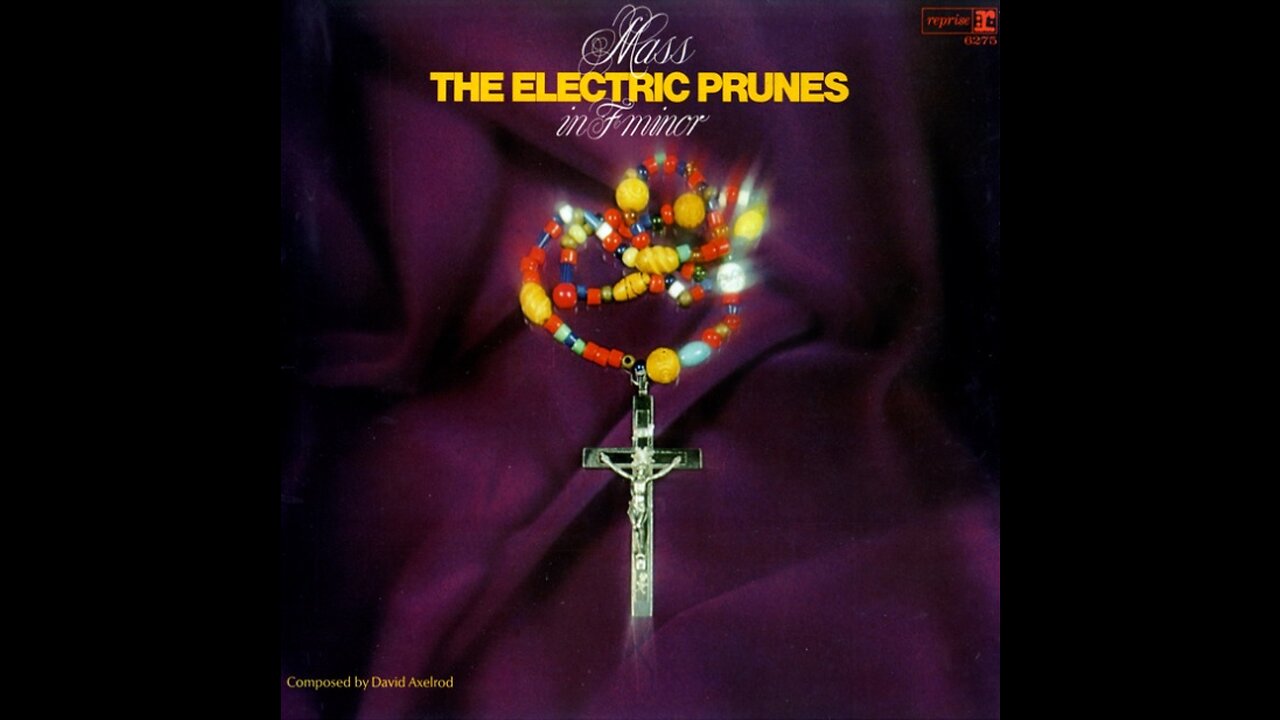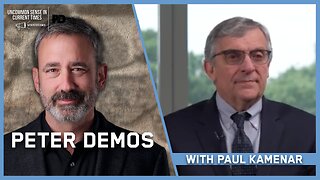Premium Only Content

The Electric Prunes - Mass in F Minor - Om is the Primordial Sound of the Universe
Om is the seed of transcendental sound, and it is through transcendental sound one can transform the mind and the senses. By chanting Om, the mind becomes aligned with the breath, which enables a person to get into an elevated state of consciousness called samadhi. So Rock Mass in F Minor is this Transcendental Sound of your Real Mind. This the third studio album by American rock band The Electric Prunes, released in 1968. It consists of a musical setting of the mass sung in Latin and Greek and arranged in the psychedelic style of the band, and was written and arranged by David Axelrod. Following the limited commercial success of the Electric Prunes' previous album, Underground, the band's manager Lenny Poncher and their producer Dave Hassinger, whose company owned the rights to the band name, agreed with Reprise Records that their third album would be written and arranged by David Axelrod, a classically trained musician. The album was planned to combine religious and classical elements with psychedelic rock, in a religious-based rock-opera concept album. Axelrod was given carte blanche by Hassinger to do what he wanted with the Electric Prunes.
Samadhi is the highest state of mental concentration that people can achieve while still bound to the body and which unites them with the highest reality.
LP-Side A-1. Kyrie Eleison (David Axelrod) - 2. Gloria (David Axelrod) - 3. Credo (David Axelrod)
LP-Side B-1. Sanctus (David Axelrod) - 2. Benedictus (David Axelrod) - 3. Agnus Dei (David Axelrod)
When the existing band – singer James Lowe, guitarists Ken Williams and Mike Gannon, bassist Mark Tulin, and drummer Michael "Quint" Weakley – came to record the album, it became apparent that the complex arrangements largely outstripped the band's ability to perform them to the standards expected by Axelrod, or within the time set aside for recording. Although Lowe, Tulin (the only band member who could read music) and Weakley appeared on all the tracks, and Williams and Gannon also appeared on the first three tracks ("Kyrie Eleison", "Gloria" and "Credo"), the album was finished by studio musicians working with engineer Richie Podolor on guitar, and a Canadian group, the Collectors. The choral-style vocals were by Lowe, double-tracked. Hassinger was credited with producing the album.
LINER NOTES FOR THE ELECTRIC PRUNES' MASS IN F MINOR
By Richie Unterberger - The background to the bizarre twist of events leading to the Electric Prunes' 1968 album Mass in F Minor needs some explanation. The Prunes' previous LP, Underground, had been the most accurate representation of their growing experimental psychedelic vision, particularly as they wrote the majority of the material. However, it had not sold too well or yielded a hit single. The producer that had signed the group to his independent production company, Dave Hassinger, was not interested in experimentation as much as he was in commercial records. With Electric Prunes manager Lenny Poncher and arranger David Axelrod, a new strategy was hatched in which Axelrod would write and arrange an album combining classical music, the sort of Gregorian vocals heard in some religious music, and freakout psychedelia. It would be sung entirely in Latin, no less.
Whether the Electric Prunes were a suitable vehicle for the experiment is questionable. "They wanted a sound from us to hang the mass on," says lead singer James Lowe. "We came in and there are these charts. We were slow and only Mark [Tulin, Electric Prunes bassist] read music." Although it is the band you hear on the three songs that comprised side one of the album ("Kyrie Eleison," "Gloria," "Credo"), the group were going too slow for Axelrod's tastes. As a consequence members of a Canadian group, the Collectors (later Chilliwack), were enlisted to help complete the album, although Lowe did all of the lead vocals, and Tulin and drummer Quint from the Prunes do play on every track. (Engineer Richie Podolor assisted on guitar as well.) "I like and respect Dave Axelrod," comments Tulin. "I think he's a brilliant musician and he greatly helped expand my musical knowledge. However, he wasn't us. We were a 'known entity' plugged into an outside concept; a means to someone else's end. Trouble was, we were a band, not an inorganic artificial product that could be manipulated at will." For all its apples-and-oranges conception, the record is a nifty psychedelic curio, with its unusual mixture of searing acid rock guitar and subdued, harmonized Gregorian singing. The quasi-choral effect, incidentally, was achieved by having Lowe double-track most of the vocals.
Undoubtedly, the most famous track on the record -- and the best one, to most ears -- is the opener, "Kyrie Eleison." The Electric Prunes were always masters of the psychedelic guitar reverb, and the first part of the song has some of their best echoed-to-infinity axework, yielding in the final section to some passages of fierce distorted sustain. This is also the only one of the six songs that features only standard rock instrumentation, without the orchestral embellishments of horns and strings Axelrod would deploy throughout the rest of the album. "Kyrie Eleison" is familiar to most listeners, of course, through its inclusion on the soundtrack to the classic 1969 counterculture film Easy Rider, starring Dennis Hopper and Peter Fonda. Somehow "Kyrie Eleison" was rescued from obscurity and used in the scenes just after Fonda and Hopper arrive in New Orleans for Mardi Gras, including the one where they visit a local brothel.
While "Kyrie Eleison" might be the Mass in F Minor cut most representative of the band, some of their character does come through via their instrumental contributions to the rest of the recording, particularly in the guitar work. There is some intense, shrieking sustain that isn't too far removed from the wildest, most distorted solos that Jorma Kaukonen was playing for the Jefferson Airplane during the After Bathing at Baxter's era. The vocal harmonies are graceful and understated, and on the whole the result is a lot less gauche than it could have been (and would be, on later rock concept albums of all stripes). Lowe, however, is understandably nonchalant when asked if there were any aspects of the experience that stuck out as highlights: "I grew up in Catholic school, my Mom was glad I was doing a mass."
The one and only live performance of the album did not go as well as it could have. Tulin: "We were on tour when we were told we would be performing the mass almost immediately upon our return. Aside from the time spent recording it, this would be the first time we played the mass; the first time we played it straight through without the stops/starts facilitated by recording. There was one rehearsal, at the Musician's Union rehearsal hall. Four celli, four French horns, six vocalists (from the Smothers Brothers show), and the band. James took charge of the vocalists and I was put in charge of the musicians. I was told I was to play bass, play the organ and conduct. Didn't work, but I believe we managed to at least talk our way through the charts. "That night, at the Santa Monica Civic Auditorium, we had the same complement of musicians/singers plus Richie Podolor (our recording engineer and a great guitarist in his own right) and Don Peake added on guitar. Don Randi was called in for the concert to play organ and conduct. Only problem was that prior to the last-minute call Don had spent the entire day on his boat. He was sunburned and burned out from the day. Everyone had to use music stands to read the charts because no one on stage knew the songs or arrangements. "From the outset the performance was a disaster. We missed the intro on the first song and it never got any better. Amp speakers blew, charts fell off music stands and everyone was, in general, in a complete state of confusion. Ended up each song turned into one long jam. I think we were, at times, all in the same key. I made my way over to the four celli and four French horns and told them to 'jam in E.' Somehow we would hit a break and James would manage a vocal. Mercifully, this all ended and as we were leaving a few 'fans' said, 'We didn't know you guys were into avant-garde jazz.'"
The Electric Prunes would break up in 1968, due to both artistic and financial frustrations. Lowe was the first to go, although one tour was done with a lineup including some of the other members and, of all people, a then-unknown Kenny Loggins. There would be two more albums that were the Electric Prunes in name only, as the name belonged to their producer, Dave Hassinger. None of the musicians on those LPs had played on the first three Electric Prunes albums, or even played in the band at all prior to 1968. A 1969 non-LP single by the group bearing the Electric Prunes monicker during that era, "Hey Mr. President"/"Flowing Smoothly," is included on this CD as bonus tracks.
In 2000, Lowe and Tulin, now established as a film/video producer and psychologist respectively, are playing together again, and making some recordings in Lowe's studio with Quint and Prunes guitarist Ken Williams. Speculates Tulin, "Our third album, had it not been the mass, I believe would have, at the very least, had a true band feel and sound, one even more representative of who we were. In addition, we were just beginning to understand how to use the studio as its own instrument. Left to our own devices I think we would have expanded that knowledge. In addition, I think we would have stretched a little more in using vocal sounds as a compliment to the band instruments. We were heading in a direction that would have allowed us to explore more intricate tonal ideas involving subtle manipulations of sound and song structure to create a more sensory and sensual experience." -- Richie Unterberger
1) Om is the primordial sound of the universe
Heard in temples, yoga studios, households, even television and movies, the chanting and symbol of Om is familiar to most as it has pervaded the western world since the counterculture of the 1960s.
While to the layperson it’s synonymous to meditation, and seen simply as a doorway to tranquility for yogic practitioners, the true meaning of Om is deeply embedded in Hindu philosophy and to comprehend its truly profound effects one must have a basic understanding of sound.
Though many comprehend sound as merely something to be heard, its mechanism is a little more complex. Sound is made up of vibrations. These vibrations are produced from a source, travel through the air, and then are picked up by the ear before being interpreted by the brain, which assigns them some value. The number of vibrations per second is known as frequency. Because all matter is composed of atomic material, which is in constant motion, everything and everyone vibrates on some frequency.
The great inventor and scientist Nikola Tesla once said, “If you want to find the secrets of the universe, think in terms of energy, frequency, and vibration.”
The word Om is defined by Hindu scripture as being the primordial sound of creation. It is the original vibration of the universe. From this first vibration, all other vibrations are able to manifest.
2) Why meditate on Om
It is well-substantiated that sound vibration significantly impacts a person’s physical, emotional, and mental state. By chanting Om, we can align our frequency with that of the original universal frequency, which is essential in spiritual practice. As an iron rod becomes as hot as fire when it comes in contact with its flames, a person can spiritualize their life by staying in contact with the spiritual energy of the Absolute.
Om is the seed of transcendental sound, and it is through transcendental sound one can transform the mind and the senses. By chanting Om, the mind becomes aligned with the breath, which enables a person to get into an elevated state of consciousness called samadhi. The activity of attaining samadhi brings the materially absorbed mind under control, which enables a person to have one-pointed focus towards spiritual realization.
Because the Absolute is beyond the understanding of the mundane material senses, spiritualizing the mind — the center of all sensual activities, through sound vibration, is necessary to set in motion the process of transcendental realization.
Like a majestic tree that can be generated from a tiny seed, the glorious tree of spirituality can grow from the sincere chanting of Om.
3) Symbolism of Om
While its symbol is recognized by most, much fewer actually know what the combination of curves, crescent, and dot, which make up Om’s visual representation, actually stand for.
Each aspect of the visual form of Om signifies a particular state of reality. The large lower curve marks the normal waking state (jāgrat). In this condition, the mind identifies with the physical body and perceives the world through the senses.
The upper curve indicates the unconscious state, or that of deep sleep (sushupti). This is a state of total unawareness, in which you are in a deep dreamless sleep, and you are withdrawn from both physical and mental activities.
The middle curve denotes the dream state (swapna). The dream state is in between the deep sleep and waking state, where a person explores the subconscious. Your consciousness is turned inwards, as your fears, hopes, and desires manifest themselves in an imaginary world.
The dot is a symbol of enlightenment (turiyā). In this state, a person becomes harmonized with the Absolute, recognizing that all of creation is made up of spirit and is united through that commonality. This state is beyond the mundane senses, and can only be achieved by associating with spiritual energy.
The crescent represents maya, which separates the three curves from the dot. Maya is the illusion that binds an individual soul to the material world. By chanting Om, one can transcend the three curves of material consciousness, and attain the dot of enlightenment.
4) Universal access of Om
Like an object depicted in numerous ways by numerous painters, Om’s essence is uniquely manifested and accessed by different types of people all over the world.
As yogis commonly conclude their meditations with the chanting of Om, the Judeo-Christian utterance of “Amen,” and the Islamic version “Amin,” are used by followers to evoke the energy of the Divine at the end of a prayer.
Even within Hinduism, the meaning and connotations of Om is perceived in a variety of ways. Though heard and often written as “om,” due to the way it sounds when it is repeatedly chanted, the sacred syllable is originally and more accurately spelled as “aum.”
Broken down, the three letters of A – U – M represent a number of sacred trinities:
The different conditions of consciousness — the waking state, the dreaming state, and the deep sleep state.
The deities in charge of the creation, preservation, and destruction of the universe — Brahma, Vishnu, and Shiva.
The three original Vedic scriptures — Rg, Yajur, and Sāma.
The three worlds — earth, atmosphere, and ether.
The three aspects of time — past, present, and future.
In the Bhakti tradition (yoga of devotion) — Krishna (seen by his devotees as the God of Creation), Rādhārāni (Krishna’s eternal consort, or God’s female counterpart), and the ordinary living beings.
Om encompasses all of creation, and its merciful energy can be attained by any who seek it, regardless of who they are, where they come from, or whichever faith they follow.
5) How to chant Om
Though there are no hard and fast rules for chanting Om, understanding the fundamental techniques of how to produce its sound can help provide a foundation from which you can better connect to the Divine.
As explained earlier, Om represents the creation, preservation, and dissolution of the universe. The seven main chakras — wheels of energy in the body relating to the physical, psychological, and spiritual aspects of our lives, provides a path through which the sound of Om begins, passes through, and eventually dissolves itself.
After taking in a deep breath, the chanting of Om (Aum) begins at the solar plexus chakra, near the diaphragm, where the “A” of the syllable is emphasized. As the sound progresses, “U” sustains the mantra through the heart, throat, and third eye chakras, until it reaches the crown. The sound dissolves at the crown chakra, at which point the mantra has developed into its last part, the “M.”
It’s most beneficial to find a quiet place where you can focus without being disturbed. Keeping your spine straight, begin chanting, starting with the “A,” holding the “U” a little longer as it progresses through the chakras, and then ending on the “M,” as the exhale of your breath ends. Chanting in a strong but not loud voice for at least 15 minutes is generally ideal if you want to truly get something substantial out of your meditative practice.
Ultimately, regardless of technique, chanting Om is about connecting to the Divine. As long as your intention is sincere, everything else will fall into place.
Summary of Religions and Beliefs
Agnosticism
Agnosticism is the view that the truth of metaphysical claims regarding, in particular, the existence of a god or gods, or even ultimate reality, is unknown and may be impossible to know. One can be an agnostic as well as an atheist or religious believer.
Atheism
Atheism describes a state of having no theistic beliefs; that is, no beliefs in gods or supernatural beings.
Baha'i
The Baha'i Faith began in Persia in 1844 with the declaration of a new religion, distinctive from the Shi'a Islam found there. Key beliefs include belief in one God; the unity of mankind; equality of opportunity for men and women; and elimination of prejudice.
Buddhism
A way of living based on the teachings of Siddhartha Gautama. The Five Precepts are the basic rules of living for lay Buddhists – refrain from harming living beings; taking what is not given; sexual misconduct; harmful speech; and drink or drugs which cloud the mind.
Christianity
Based on the teaching of Jesus Christ. Christian groups differ in their interpretation of his teaching, life, death and resurrection, but these matters are at the heart of the way of life of all of them. What Christians believe...
Humanism
Humanism is the belief that we can live good lives without religious or superstitious beliefs. Humanists make sense of the world using reason, experience and shared human values and aim to make the best of the life we have by creating meaning and purpose for ourselves. Humanists work with others for the common good. [symbol © British Humanist Association].
Hinduism
An ancient tradition of related beliefs and practices that developed in the Indian subcontinent. Core ideals and values shared by most Hindus would include respect for elders; reverence for teachers; regard for guests and tolerance of all races and religions. What Hindus believe...
Islam
Revealed in its final form by the Prophet Muhammad (peace be upon him). The essentials of Muslim practice are summarized in the five pillars of Islam – declaration of faith; ritual prayer; welfare; a month of fasting during Ramadan; and pilgrimage. What Muslims believe...
Jainism
An ancient philosophy and ethical teaching that originated in India. The main principle is ahimsa – the avoidance, where possible, of physical or mental harm to any living being. Jainism is a religion without a belief in a creator god.
Judaism
Based around the Jewish people's covenant relationship with God. Jews believe they are challenged and blessed by God. Love of one's neighbor is the great principle of social life and the founding inspiration of the Jewish community. What Jews believe...
Sikhism
The religion founded by Guru Nanak in India in the 15th Century CE. There is one God, people should serve by leading a life of prayer and obedience. Sikhs believe their soul then passes through various existences and will become one with God.
Zoroastrianism
Zoroastrianism is a religion founded in ancient times by the prophet Zarathushtra, who taught that Ahura Mazda (Lord of Wisdom), the all powerful and perfect creator, grants humans Vohu Manah – a clear rational mind with which to dispel ignorance.
Connecting with the Divine - The major religions of the world and their beliefs…
We all want to make it through life with success, some sense that we did it right. So what about the major world religions? Is there anything in them that might give our lives greater depth and direction?
The following looks at the major world religions... Hinduism, New Age Spirituality, Buddhism, Islam, and Christianity.* There is a brief description of each, their view of God, and what a person can gain from that religion. The ending explains how Jesus' teaching differs from the major religions.
*Each of these religions has sects with differing beliefs. The description given here focuses on the core beliefs of each religion. Other major religions, such as Judaism, could be discussed, but for brevity, we have chosen these.
Hinduism and its beliefs
Illustration of Hinduism with arrows all pointing in various directions to show infinite manifestations of God. Most Hindus worship one Being of ultimate oneness (Brahman) through infinite representations of gods and goddesses. These various deities become incarnate within idols, temples, gurus, rivers, animals, etc.
Hindus believe their position in this present life was determined by their actions in a previous life. Hinduism therefore provides a possible explanation for suffering and evil in this life. If a person’s behavior before was evil, they might justifiably experience tremendous hardships in this life. Pain, disease, poverty or a disaster like a flood is deserved by that person because of their own evil actions, usually from a previous lifetime.
A Hindu's goal is to become free from the law of karma...to be free from continuous reincarnations. Only the soul matters which will one day be free of the cycle of rebirths and be at rest.
Hinduism lets a person choose how to work toward spiritual perfection. There are three possible ways to end this cycle of karma: 1. Be lovingly devoted to any of the Hindu deities; 2. Grow in knowledge through meditation of Brahman (oneness)...to realize that circumstances in life are not real, that selfhood is an illusion and only Brahman is real; 3. Be dedicated to various religious ceremonies and rites.
New Age Spirituality and its beliefs
Illustration of New Age Spirituality, showing arrows interconnecting in a circle, to illustrate that a person becomes their own God. New Age Spirituality promotes the development of the person's own power or divinity. When referring to deity, a follower of this type of spirituality is not talking about a transcendent, personal God who created the universe, but is referring to a higher consciousness within themselves. A person pursuing spiritual development would see themselves as deity, the cosmos, the universe. In fact, everything that the person sees, hears, feels or imagines is to be considered divine.
Highly eclectic, New Age Spirituality is a collection of ancient spiritual traditions, taught by a vast array of speakers, books and seminars. It acknowledges many gods and goddesses, as in Hinduism. The Earth is viewed as the source of all spirituality, and has its own intelligence, emotions and deity. But superseding all is self. Self is the originator, controller and power over all. There is no reality outside of what the person determines.
New Age teaches eastern mysticism and spiritual, metaphysical and psychic techniques, such as breathing exercises, chanting, drumming, meditating...to develop an altered consciousness and one's own divinity.
Anything negative a person experiences (failures, sadness, anger, selfishness, hurt) is considered an illusion. Believing themselves to be completely sovereign over their life, nothing about their life is wrong, negative or painful. Eventually, a person develops spiritually to the degree that there is no objective, external reality. A person, becoming a god, creates their own reality.
Buddhism and its beliefs
Illustration of Buddhism, with a universal sign of nill, a circle with a slanted line through it, to illustrate that Buddhists do not believe in any God. Buddhists do not worship any gods or God. People outside of Buddhism often think that Buddhists worship the Buddha. However, the Buddha (Siddhartha Gautama) never claimed to be divine, but rather he is viewed by Buddhists as having attained what they are also striving to attain, which is spiritual enlightenment and, with it, freedom from the continuous cycle of life and death.
Most Buddhists believe a person has countless rebirths, which inevitably include suffering. A Buddhist seeks to end these rebirths. Buddhists believe it is a person's cravings, aversion and delusion that cause these rebirths. Therefore, the goal of a Buddhist is to purify one's heart and to let go of all yearnings toward sensual desires and the attachment to oneself.
Buddhists follow a list of religious principles and adhere to personal restraint, fasting and very dedicated meditation. When a Buddhist meditates it is not the same as praying or focusing on a god, it is more of a self-discipline. Through practiced meditation, a person may reach Nirvana -- "the blowing out" of the flame of desire.
Buddhism provides something that is true of most major religions: disciplines, values and directives that a person may want to live by.
Islam and its beliefs
Illustration of Islam, with one arrow pointing up to a transcendent God, to illustrate the relationship with God is one serving that God. Muslims believe there is the one almighty God, named Allah, who is infinitely superior to and transcendent from humankind. Allah is viewed as the creator of the universe and the source of all good and all evil. Everything that happens is Allah's will. He is a powerful and strict judge, who will be merciful toward followers depending on the sufficiency of their life's good works and religious devotion. A follower's relationship with Allah is as a servant to Allah.
Though a Muslim honors several prophets, Muhammad is considered the last prophet, and his words and lifestyle are that person's authority. To be a Muslim, one must follow five religious duties: 1. Repeat a creed about Allah and Muhammad; 2. Recite certain prayers in Arabic five times a day; 3. Give to the needy; 4. One month each year, fast from food, drink, sex and smoking from sunrise to sunset; 5. Pilgrimage once in one's lifetime to worship at a shrine in Mecca. At death -- based on one's faithfulness to these duties -- a Muslim hopes to enter Paradise. If not, they will be eternally punished in hell.
For many people, Islam matches their expectations about religion and deity. Islam teaches that there is one supreme deity, who is worshiped through good deeds and disciplined religious rituals. After death, a person is rewarded or punished according to their religious devotion. Muslims believe that giving up one’s life for Allah is a sure way of entering Paradise.
Christianity and its beliefs
Illustration of Christianity, with an arrow of God reaching down to an arrow of a person being able to connect with God. Christians believe in one eternal God who is creator of all that is. He is viewed as a loving God who offers everyone a personal relationship with himself now in this life.
In his life on Earth, Jesus Christ did not identify himself as a prophet pointing to God or as a teacher of enlightenment. Rather, Jesus claimed to be God in human form. He performed miracles, forgave people of their sin and said that anyone who believed in him would have eternal life.
Followers of Jesus regard the Bible as God's written message to humankind. In addition to being a historical record of Jesus' life and miracles, the Bible reveals his personality, his love and truth, and how one can know and relate to God, as you could a friend.
Christians believe that all people sin, including themselves. They see Jesus as their Savior, as the Messiah who was prophesied by all the prophets of the Old Testament, in the Bible. They believe that Jesus Christ, out of love for us, paid for the sin of all of humanity by dying on a cross. Three days later, he rose from the dead as he promised, proving his deity.
How distinct are these major religions?
In looking at these major belief systems and their views of God, we find tremendous diversity:
Hindus acknowledge multitudes of gods and goddesses.
Buddhists say there is no deity.
New Age Spirituality followers believe they are God.
Muslims believe in a powerful but unknowable God.
Christians believe a loving God who created us to know him.
Are all religions worshiping the same God? Let's consider that. New Age Spirituality teaches that everyone should come to center on a cosmic consciousness, but it would require Islam to give up their one God, Hinduism to give up their numerous gods, and Buddhism to establish that there is a God.
What does each religion require?
The world's major religions (Hinduism, New Age Spirituality, Buddhism, Islam, Christianity) are also quite unique in their requirements.
Photo of a smiling young man to illustrate that in Christianity there is not the burden to earn God's acceptance. Most of the world religions place an individual on their own, striving for spiritual perfection.
In Hinduism, a person is on their own trying to gain release from karma. In New Age, a person is working at their own divinity. In Buddhism, it is an individual quest at being free from desire. And in Islam, the individual follows religious laws for the sake of paradise after death.
All religions are working on the same problem.
We’re all aware of personal failings and the need to be better. This is what leads to the creation of religions.
We also want to feel at peace, fulfilled and have inner strength. And so we move to practices like meditation, religious rituals, self-help books, fasting, prayer, personal sacrifice, pilgrimages, etc.
We hope these will increase our inner goodness and make amends for our sins.
While striving for enlightenment, Buddha never claimed sinlessness. Muhammad also admitted that he was in need of forgiveness. "No matter how wise, no matter how gifted, no matter how influential other prophets, gurus, and teachers might be, they had the presence of mind to know that they were imperfect just like the rest of us."1
Sacrifices in various religions
In most religions, you see some type of sacrifice required to pay for sin.
man meditating in worship In Hinduism, sacred fires can be used to overcome sin, suffering and adversity. In other religions, it is common to require hours in prayer or meditation multiple times a day; periods of fasting; financial sacrifices; long pilgrimages.
The prophet Isaiah is a prophet honored in Judaism, Christianity and Islam. Instead of our striving to pay for our sins, Isaiah wrote of a coming Savior who would personally pay for the sins of all humanity:
“All we like sheep have gone astray; we have turned—every one—to his own way; and the Lord has laid on him the iniquity [sin] of us all.”2
Jesus Christ identified himself as this Savior that Isaiah talked about. “…the lamb of God who takes away the sin of the world.”3
Jesus told his followers that he would lay down his life “poured out for many, for the forgiveness of sins.”4
Forgiveness for sin
Indeed, Jesus was whipped, beaten, a crown of long thorns pressed into his head, then his hands and feet nailed to a cross where he hung until death, willingly dying in our place.
The prophet Isaiah wrote, “he was crushed for our iniquities…he poured out his soul to death…an offering for guilt…he bore the sin of many.”5
The Bible says, "By this we know love, that he laid down his life for us."6
Our sin was paid for by Jesus on the cross. He now offers us complete forgiveness and welcomes us to freely come to him.
Life after death
Throughout his public life, thousands of people followed Jesus, as he performed countless miracles, healing the sick, causing the lame to walk, the blind to see, feeding crowds of 5,000 people.
Unlike other spiritual leaders, Jesus said he himself would judge the world, forgive sin, give people eternal life, answer prayers…attributes belonging only to God. Over and over he identified himself as equal to God, leading to his crucifixion.
However, Jesus also offered final proof of his deity, saying he would rise from the dead three days after his burial.
He didn't say he would reincarnate someday into a future life. (Who would know if he actually did it?)
Photo of a smiling young woman to illustrate that in Christianity there is not the burden to earn God's acceptance. Jesus’ power to perform miracles was so widely known, his executors stationed soldiers at the entrance of Jesus’ burial tomb to secure it.
Despite that, on that third day, Jesus' tomb was found empty and many people testified that they saw him alive again.
News spread throughout the world that any person could be fully forgiven by Jesus and know him for all eternity by believing in him. The message was clear.
"For God so loved the world that he sent his one and only Son, that whoever believes in him should not perish, but have eternal life."7
(To know more about Jesus see Why Jesus is God.)
Jesus offers us a relationship with himself and eternal life.
Unlike many world religions…
God invites us to freely come to him. This is not a commitment to a method of self-improvement like the Eight Fold Path or the Five Pillars, or meditation, or good works, or obeying the Ten Commandments.
These seem clear, well-defined, easy-to-follow paths for spirituality. But they become a burdensome striving for perfection, and connection with God is still distant. Religious efforts or good deeds are insufficient to cover our sin.
Instead, we can know Jesus our Savior who fully accepts us because of his death for our sins and our faith in him.
Not religion – a relationship with God
He welcomes you to know him. The question is, do you want a relationship with God?
If so, you can begin a relationship with God right now. It is as simple as sincerely asking him for his forgiveness of your sin and inviting him to enter your life.
Photo of a smiling young woman to illustrate that in Christianity there is not the burden to earn God's acceptance. Jesus said, "Behold, I stand at the door [of your heart] and knock. If anyone hears my voice and opens the door, I will come into him."8
You can open that door and invite him into your life right now, by simply asking him in prayer. The exact words are not important, but this might help you express it:
“God, I ask you to forgive me and invite you to enter my heart right now. Thank you, Jesus, for dying for my sins. Come into my life as you offered. Thank you for giving me an eternal relationship with you."
If you asked God to come into your life just now, you have begun a personal relationship with him. You can talk with him and he will guide you in this life now. Unlike world religions, Jesus doesn’t point you to a path, a philosophy, or rituals, but to personally know him and his love for you.
-
 8:23:08
8:23:08
What If Everything You Were Taught Was A Lie?
17 days agoMystery Of Tartarian And Hidden Evidence To Lost History 3,000+ Images Of Forbidden History
4.21K4 -
 LIVE
LIVE
Right Side Broadcasting Network
9 days agoLIVE REPLAY: President Donald J. Trump Keynotes TPUSA’s AmFest 2024 Conference - 12/22/24
10,581 watching -
 4:31
4:31
CoachTY
16 hours ago $12.14 earnedCOINBASE AND DESCI !!!!
52K7 -
 10:02
10:02
MichaelBisping
16 hours agoBISPING: "Was FURY ROBBED?!" | Oleksandr Usyk vs Tyson Fury 2 INSTANT REACTION
12.5K7 -
 8:08
8:08
Guns & Gadgets 2nd Amendment News
2 days ago16 States Join Forces To Sue Firearm Manufacturers Out of Business - 1st Target = GLOCK
63K62 -
 10:17
10:17
Dermatologist Dr. Dustin Portela
1 day ago $12.40 earnedOlay Cleansing Melts: Dermatologist's Honest Review
85.8K5 -
 1:02:20
1:02:20
Trumpet Daily
2 days ago $31.29 earnedObama’s Fake World Comes Crashing Down - Trumpet Daily | Dec. 20, 2024
54.5K41 -
 6:29
6:29
BIG NEM
1 day agoCultivating God Mode: Ancient Taoist NoFap Practices
42.9K9 -
 30:53
30:53
Uncommon Sense In Current Times
2 days ago $9.36 earned"Pardon or Peril? How Biden’s Clemency Actions Could Backfire"
61.6K4 -
 40:01
40:01
CarlCrusher
22 hours agoSkinwalker Encounters in the Haunted Canyons of Magic Mesa - ep 4
57.6K3